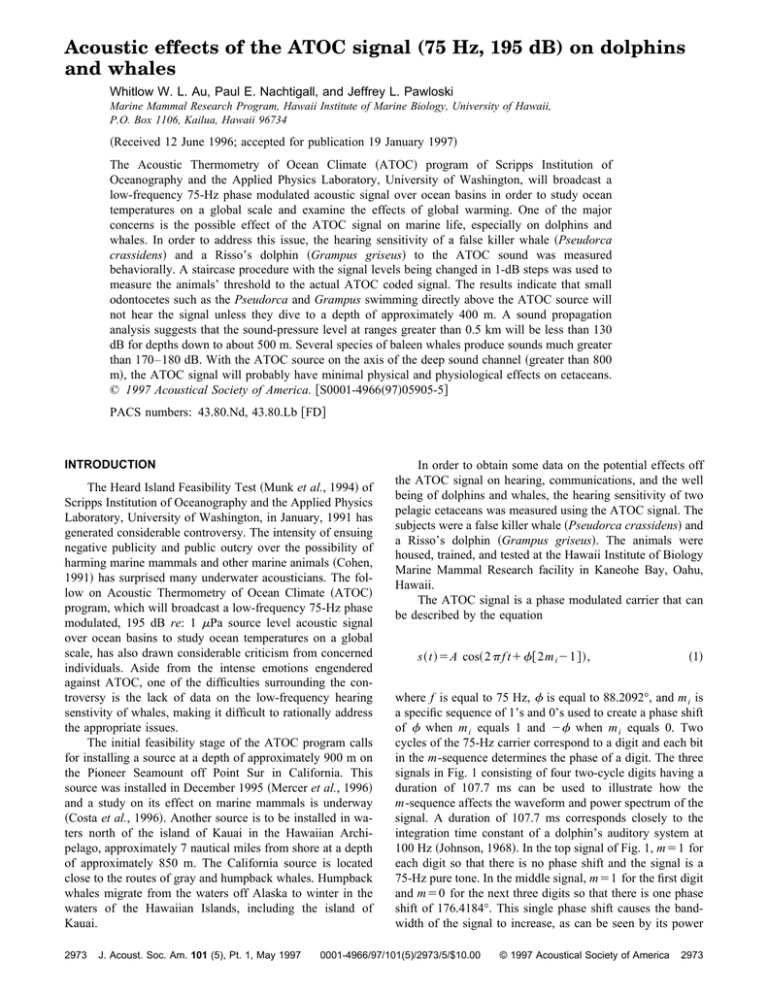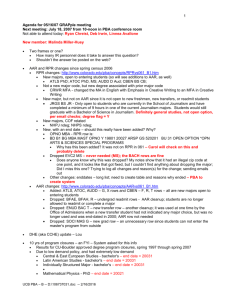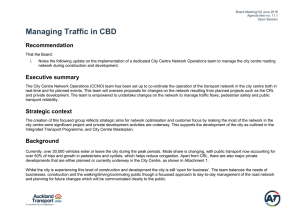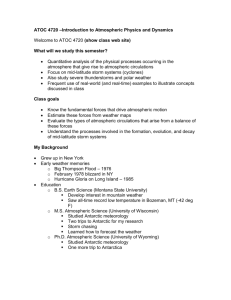Acoustic effects of the ATOC signal (75 Hz, 195 dB)
advertisement

Acoustic effects of the ATOC signal (75 Hz, 195 dB) on dolphins and whales Whitlow W. L. Au, Paul E. Nachtigall, and Jeffrey L. Pawloski Marine Mammal Research Program, Hawaii Institute of Marine Biology, University of Hawaii, P.O. Box 1106, Kailua, Hawaii 96734 ~Received 12 June 1996; accepted for publication 19 January 1997! The Acoustic Thermometry of Ocean Climate ~ATOC! program of Scripps Institution of Oceanography and the Applied Physics Laboratory, University of Washington, will broadcast a low-frequency 75-Hz phase modulated acoustic signal over ocean basins in order to study ocean temperatures on a global scale and examine the effects of global warming. One of the major concerns is the possible effect of the ATOC signal on marine life, especially on dolphins and whales. In order to address this issue, the hearing sensitivity of a false killer whale ~Pseudorca crassidens! and a Risso’s dolphin ~Grampus griseus! to the ATOC sound was measured behaviorally. A staircase procedure with the signal levels being changed in 1-dB steps was used to measure the animals’ threshold to the actual ATOC coded signal. The results indicate that small odontocetes such as the Pseudorca and Grampus swimming directly above the ATOC source will not hear the signal unless they dive to a depth of approximately 400 m. A sound propagation analysis suggests that the sound-pressure level at ranges greater than 0.5 km will be less than 130 dB for depths down to about 500 m. Several species of baleen whales produce sounds much greater than 170–180 dB. With the ATOC source on the axis of the deep sound channel ~greater than 800 m!, the ATOC signal will probably have minimal physical and physiological effects on cetaceans. © 1997 Acoustical Society of America. @S0001-4966~97!05905-5# PACS numbers: 43.80.Nd, 43.80.Lb @FD# INTRODUCTION The Heard Island Feasibility Test ~Munk et al., 1994! of Scripps Institution of Oceanography and the Applied Physics Laboratory, University of Washington, in January, 1991 has generated considerable controversy. The intensity of ensuing negative publicity and public outcry over the possibility of harming marine mammals and other marine animals ~Cohen, 1991! has surprised many underwater acousticians. The follow on Acoustic Thermometry of Ocean Climate ~ATOC! program, which will broadcast a low-frequency 75-Hz phase modulated, 195 dB re: 1 mPa source level acoustic signal over ocean basins to study ocean temperatures on a global scale, has also drawn considerable criticism from concerned individuals. Aside from the intense emotions engendered against ATOC, one of the difficulties surrounding the controversy is the lack of data on the low-frequency hearing senstivity of whales, making it difficult to rationally address the appropriate issues. The initial feasibility stage of the ATOC program calls for installing a source at a depth of approximately 900 m on the Pioneer Seamount off Point Sur in California. This source was installed in December 1995 ~Mercer et al., 1996! and a study on its effect on marine mammals is underway ~Costa et al., 1996!. Another source is to be installed in waters north of the island of Kauai in the Hawaiian Archipelago, approximately 7 nautical miles from shore at a depth of approximately 850 m. The California source is located close to the routes of gray and humpback whales. Humpback whales migrate from the waters off Alaska to winter in the waters of the Hawaiian Islands, including the island of Kauai. 2973 J. Acoust. Soc. Am. 101 (5), Pt. 1, May 1997 In order to obtain some data on the potential effects off the ATOC signal on hearing, communications, and the well being of dolphins and whales, the hearing sensitivity of two pelagic cetaceans was measured using the ATOC signal. The subjects were a false killer whale ~Pseudorca crassidens! and a Risso’s dolphin ~Grampus griseus!. The animals were housed, trained, and tested at the Hawaii Institute of Biology Marine Mammal Research facility in Kaneohe Bay, Oahu, Hawaii. The ATOC signal is a phase modulated carrier that can be described by the equation s ~ t ! 5A cos~ 2 p f t1 f @ 2m i 21 # ! , ~1! where f is equal to 75 Hz, f is equal to 88.2092°, and m i is a specific sequence of 1’s and 0’s used to create a phase shift of f when m i equals 1 and 2f when m i equals 0. Two cycles of the 75-Hz carrier correspond to a digit and each bit in the m-sequence determines the phase of a digit. The three signals in Fig. 1 consisting of four two-cycle digits having a duration of 107.7 ms can be used to illustrate how the m-sequence affects the waveform and power spectrum of the signal. A duration of 107.7 ms corresponds closely to the integration time constant of a dolphin’s auditory system at 100 Hz ~Johnson, 1968!. In the top signal of Fig. 1, m51 for each digit so that there is no phase shift and the signal is a 75-Hz pure tone. In the middle signal, m51 for the first digit and m50 for the next three digits so that there is one phase shift of 176.4184°. This single phase shift causes the bandwidth of the signal to increase, as can be seen by its power 0001-4966/97/101(5)/2973/5/$10.00 © 1997 Acoustical Society of America 2973 FIG. 1. Examples of the ATOC signal in a 107-ms interval showing the effects of the 88.2092° phase shift. spectrum. In the bottom signal, m51 for the first digit, m50 for the second and third digit, and then m51 for the fourth digit. Therefore, there are two 176.4184° phase shifts in the bottom signal that cause the spectrum to broaden. The m-sequence is used in conjunction with cross correlation processing to precisely determine the time of arrival of the signal after it has traveled several thousand miles across the ocean. Changes in the integrated ocean temperature can be determined by examining changes in the arrival time. A correlation type received will also be helpful in extracting the signal out of noise. However, using such a scheme for the signal affects the bandwidth of the signal. Therefore, the hearing threshold of a marine mammal will probably be lower with the ATOC sound than with a 75-Hz pure tone since the broadening of the spectrum may cause energy to spill into critical bands that are adjacent to the one at 75 Hz. I. METHODS A go/no-go experimental procedure was used in measuring the animals’ sensitivity to the ATOC signal and to other pure-tone signals. A trial began with the subjects swimming into a stationing hoop facing a J-13 transducer two meters from the hoop, as depicted in Fig. 2. When the subject stationed properly, the experimenter activated an underwater light alerting the animal to expect an acoustic signal. The underwater light remained on until the cessation of a trial. For a signal present trial, a signal was projected 1 s after the activation of the light. If the signal was audible to the subject it would back out of the hoop and touch a response paddle ~go response!. For a signal absent trial, the animal was required to remain in the hoop until the experimenter presented an audible 12-kHz bridge tone to release the animal from station ~no-go response!. The subject received a food reward for correct responses and did not receive reinforcement for wrong responses. A modified Gellerman series ~Gellerman, 1933! was used for the signal presentation schedule in which an equal number of signal present and signal absent trials were conducted per ten trial block with the stipulation that the signal condition not be the same for more than three consecutive trials. An up–down staircase procedure was used to determine the subject’s threshold of hearing. After a ten-trial warm-up period in which a constant supra-threshold level signal was used, the signal level was reduced by 2 dB for every correct signal present response until the animal made its first miss, which constituted a reversal. The signal level was then progressively increased in 1-dB steps until the next correct signal present response was made. Thereafter, the signal level was changed in 1-dB steps depending on the animal’s response during signal present trails. A session continued until ten reversals occurred. A threshold was defined when the average signal level per session at the reversal points for two consecutive sessions was within 3 dB. The simulated ATOC signal was generated using a DATEL PC-420 12-bit arbitrary waveform generator board with the 32 736 points of an m-sequence signal stored in on-board memory and clocked out continuously at a rate of 1200 Hz. When the experimenter activated the signal-present switch of a signal shaping circuit, the DATEL PC-420 output was amplitude modulated with a 3-s trapozoidal pulse having a 0.3-s rise and fall time to produce the stimulus signal. The signal level was controlled by a rotary attenuator. Pure-tone signals were produced in a similar fashion with the signal gated on and turned off by modulating a continuous signal with the trapozoidal pulse. The signal level at the hoop station was calibrated with an International Transducer Inc. ITC-1032 spherical hydrophone connected in a differential mode to a Princeton Applied Research PAR-113 low-noise amplifier and an oscilloscope. II. RESULTS AND DISCUSSION FIG. 2. Experimental geometry showing a Pseudorca crassidens facing a J-13 transducer. 2974 J. Acoust. Soc. Am., Vol. 101, No. 5, Pt. 1, May 1997 The mean and standard deviation of the Grampus’ thresholds were 142.261.7 dB for the 75-Hz pure-tone signal and 140.861.1 dB for the ATOC signal. The Pseudorca’s thresholds were 140.761.2 dB for the 75-Hz pure-tone signal and 139.061.1 dB for the ATOC signal. The difference between the threshold for the 75-Hz and ATOC signals for both animals was significant to the 0.01 level ~paired t-test!. These thresholds are plotted in Fig. 3 along with other low-frequency pure-tone thresholds for the same two animals obtained by Nachtigall et al. ~1995! and for another Pseudorca measured by Thomas et al. ~1988!. The data of Nachtigall et al. ~1995! are included here to compare the Au et al.: Effects of ATOC signals on cetaceans 2974 FIG. 3. Hearing threshold results for the ATOC signal and other pure-tone signals. The results at frequencies other than 75 Hz are from Nachtigall et al. ~1995!. 75-Hz threshold with other low-frequency thresholds and to illustrate the fact that the auditory system of these odonotocetes is adapted for high ultrasonic frequencies. The puretone thresholds are similar to those obtained by Johnson ~1967! for Tursiops truncatus and for Johnson et al. ~1989! for Delphinapterus leucas at frequencies close to 75 Hz. These odontocetes are relatively insensitive to low-frequency sounds; Pseudorca has a maximum sensitivity of approximately 39 dB re: 1 mPa at 65 kHz ~Thomas et al., 1988!, which is 100 dB better than at 75 Hz. The effects of the ATOC signal on these animals can be considered by examining the propagation loss profile of the FIG. 5. Sound-pressure level of the ATOC signal as a function of depth for horizontal ranges of 0, 0.5, 1, and 2 km from the source. ATOC source. The transmission loss profile for the proposed Kauai location was obtained with a computer program that used a finite element parabolic equation ~FEPE! solution ~Collins and Westwood, 1991! to the two-dimensional wave equation and a vertical sound velocity and a bottom depth profile appropriate to Kauai. The transmission loss profile for the case in which the signal is traveling directly toward shore is shown in Fig. 4, where the black line denotes the bottom contour. This figure illustrates the complexity of the propagation conditions caused by the signal reflectioning off the surface and bottom. The propagation condition reflected in Fig. 4 is probably the most severe in terms of affecting marine mammals since the signal is propagating toward an up- FIG. 4. Propagation loss profile for the ATOC source at the Kauai location obtained with a finite element parabolic equation solution to the two-dimensional wave equation. 2975 J. Acoust. Soc. Am., Vol. 101, No. 5, Pt. 1, May 1997 Au et al.: Effects of ATOC signals on cetaceans 2975 TABLE I. Examples of some baleen whale low-frequency sounds ~from Richardson et al., 1995!. Species of whale Blue Bowhead Fin Gray Humpback Minke Signal type moans moans moans moans moans grunts horn blast songs down sweep moans/grunts Frequency range ~Hz! Dominant frequencies ~Hz! 12–390 25–900 14–118 20–1200 20–1800 25–1900 ••• 30–8000 60–1300 60–140 16–25 100–400 20 20–200 35–360 ••• 410–420 120–4000 ••• 60–140 ward sloping bottom which can reflect the signal back into the water column. In order to obtain a more detailed understanding of the sound field close to the location of the source, some of the values used to generate the tranmission loss profile were used to calculate the sound-pressure levels as a function of depth and range. The results are shown in Fig. 5, with soundpressure level depicted as a function of depth at different horizontal ranges from the source. The curve at R50 was obtained by summing the upward moving direct signal with a 180° phase shifted downward moving surface reflected signal, with both components undergoing spherical spreading losses. The R50 curve suggests that small ceteceans such as Grampus and Pseudorca swimming directly over the ATOC source will not hear the transmitted sound unless the animals dove to a depth of approximately 400 m. If these animals were at a horizontal range greater than 0.5 km, the level of the ATOC signal will be below their hearing threshold at any depth. The curves of Fig. 5 also indicate that for ranges greater than 0.5 km, the maximum sound-pressure level above a depth of 560 m is approximately 130 dB. As the range increases beyond 2 km, the sound-pressure level will become progressively lower. The in-air equivalence of an underwater sound-pressure level of 130 dB can be determined by equating the intensity ~power/area! of an acoustic signal in both media. It would not be meaningful to directly compare the acoustic pressure in both media because the large difference in the density causes the acoustic power or intensity to be very different. Acoustic intensity is defined as I5 p2 , rc ~2! where r is the density and c is the sound velocity of the medium. The product rc is known as the specific acoustic impedance and is approximately equal to 1.53106 Pa s/m in water and 416 Pa s/m in air. Therefore, an underwater acoustic signal of 130 dB is equivalent to 3.16 Pa with an intensity of 6.731026 w/m2. Letting the intensity of the underwater acoustic signal be equal to the intensity of an airborne acoustic signal, the resulting airborne acoustic pressure will be 0.053 Pa or 94.4 dB re: 1 mPa. Airborne sounds are typically expressed in dB re: 20 mPa and the acoustic pressure using this reference has the notation SPL following the dB value. 2976 J. Acoust. Soc. Am., Vol. 101, No. 5, Pt. 1, May 1997 SPL at 1 m ~dB re: 1 mPa! SPL at 50 m ~dB re: 1mPa! 188 128–178 160–186 185 175 190 185 144–174 165 151–175 154 94–144 126–152 151 141 156 151 110–140 131 123–141 Therefore, 94.4 dB re: 1 mPa in air is equal to 68.4 dB SPL and is equivalent to a 130 dB re: 1 mPa underwater acoustic signal. An automobile traveling at 35 mph produces a sound of approximately 72 dB SPL 50 ft from it ~Kryter, 1985!. An obvious question at this point is the possible effects of the ATOC sound on large baleen whales. One way of addressing this question is to consider sounds that whales themselves make near their conspecifics and to compare these sounds with the ATOC sound field shown in Figs. 4 and 5. It is unfortunate that there are almost no data available on the hearing sensitivity and frequency range of hearing for baleen whales. The frequencies and sound-pressure levels of low-frequency sounds produced by some baleen whales are shown in Table I, with the data extracted from a table in Richardson et al. ~1995!. From Table I it is clear that some whales produce low-frequency sounds that have levels at 50 m that are greater than 130 dB, and levels on the order of 150 dB are not uncommon. If these whales are not physically harmed by conspecifics producing levels of sounds on the order of 150 dB at 50 m, then the ATOC sound at a soundpressure level of 130 dB or less will probably be relatively harmless to them physically. Furthermore, the bandwidth of the ATOC sound is relatively narrow and would not be as effective in masking as would the broader bandwith sounds normally produced by some whales themselves. ACKNOWLEDGMENTS The authors would like to express their appreciation to Dr. Kurt Metzger of the University of Michigan for supplying the ATOC signal in ASCII format and to Kevin Heaney of the Scripps Oceanographic Institution for providing us with propagation loss calculations. Special thanks to Dr. Robert Gisiner of the Office of Naval Research ~Grant No. N0001496WX30364! and Dr. Christopher Clark of the Bioacoustic Research Program, Cornell University for funding the threshold experiment. The comments of two anonymous reviewers were greatly appreciated. This work relates to the Advanced Research Projects Agency Grant No. MDA97293-1-0003 funded by the Strategic Environmental Research and Development Program ~SERDP!. The United States Government has a royalty-free license throughout the world in all copyrightable material herein. This is Hawaii Institute of Marine Biology contribution 1020. Au et al.: Effects of ATOC signals on cetaceans 2976 Cohen, J. ~1991!. ‘‘Was underwater ‘shot’ harmful to the whales?’’ Science 252, 912–914. Collins, M. D., and Westwood, E. K. ~1991!. ‘‘A higher-order energyconserving parabolic equation for range-dependent ocean depth, sound speed, and density,’’ J. Acoust. Soc. Am. 89, 1068–1075. Costa, D. P., Crocker, D. E., Croll, D., Goley, D., Houser, D., LeBoeuf, B. J., Waples, D., and Webb, P. ~1996!. ‘‘Effects of the California ATOC experiment on marine mammals,’’ J. Acoust. Soc. Am. 100, 2581 ~A!. Gellerman, L. W. ~1933!. ‘‘Chance orders of alternating stimuli in visual discrimination,’’ J. Gen. Psychol. 42, 206–208. Johnson, C. S. ~1967!. ‘‘Sound detection thresholds in marine mammals,’’ in Marine BioAcoustics, edited by W. N. Tavoga ~Pergamon, New York!, pp. 247–260. Johnson, C. S. ~1968!. ‘‘Relation between absolute threshold and durationof-tone pulses in the bottlenose porpoise,’’ J. Acoust. Soc. Am. 43, 757– 763. Johnson, C. S., McManus, M. W., and Skaar, D. ~1989!. ‘‘Masked tonal hearing thresholds in the beluga whale,’’ J. Acoust. Soc. Am. 85, 2651– 2654. 2977 J. Acoust. Soc. Am., Vol. 101, No. 5, Pt. 1, May 1997 Kryter, K. D. ~1985!. The Effects of Noise on Man ~Academic, Orlando, FL!. Munk, W. H., Spindel, R. C., Baggeroer, A., and Birdsall, T. G. ~1994!. ‘‘The Heard Island feasibility test,’’ J. Acoust. Soc. Am. 96, 2330–2342. Mercer, J. A., Howe, B. M., Dushaw, B. D., Spindel, R. C., Worcester, P. F., Colosi, J. A., Cornuelle, B. D., Dziechiuch, M. A., Munk, W. H., Birdsall, T., and Metzger, K. ~1996!. ‘‘Acoustic thermometry of ocean climate. A description of the acoustic network,’’ J. Acoust. Soc. Am. 100, 2580 ~A!. Nachtigall, P. E., Au, W. W. L., Pawloski, J. A., and Moore, P. W. B. ~1995!. ‘‘Risso’s dolphin ~Grampus griseus! hearing thresholds in Kaneohe Bay in Sensory Systems of Aquatic Mammals, edited by R. A. Kastelein, J. A. Thomas, and P. E. Nactigall ~De Spil, Woerden, The Netherlands!, pp. 49–53. Richardson, W. J., Green, Jr., C. R., Malme, C. I., and Thomson, D. H. ~1995!. Marine Mammals and Noise ~Academic, San Diego!. Thomas, J., Chun, N., Au, W., and Pugh, K. ~year!. ‘‘Underwater audiogram of a false killer whale ~Pseudorca crassidens!,’’ J. Acoust. Soc. Am. 84, 936–940. Au et al.: Effects of ATOC signals on cetaceans 2977






